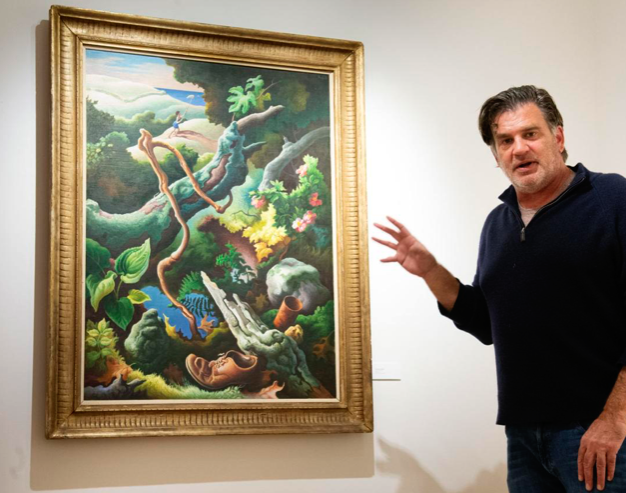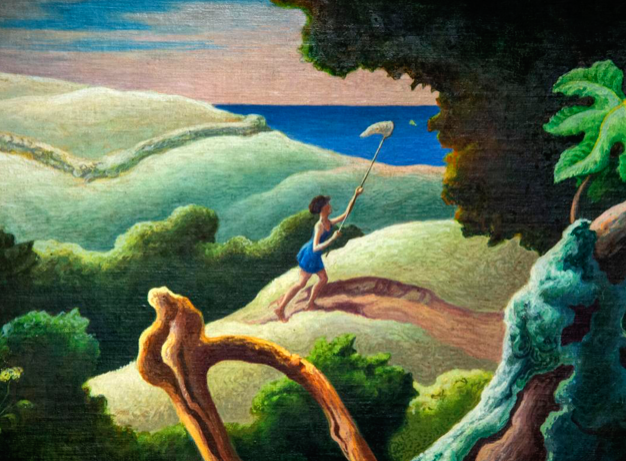Thomas Hart Benton masterpiece ‘Butterfly Chaser’ being shown for first time ever at Kiechel Fine Art
by: L. Kent Wolgamott, via the Lincoln Journal Star, Lincoln, Nebraska

Each year, Thomas Hart Benton gave his daughter, Jessie, a painting on her birthday.
Most of them thrilled her, capturing elements that corresponded to that year in her life, from the cat that is in her 1-year-old painting to seashells and ocean views that reflect the summers at Martha’s Vineyard, to blooming roses, symbolizing June, the month of her birth.
“There were a couple disappointments,” she said in a recorded interview. “The ‘Butterfly Chaser’ was one of them, in that, I asked for 10 butterflies. That’s what I wanted for my (12th) birthday. I was very into catching butterflies. I could never put the pin in them. And I would let them go. But it was just this passion of being able to catch something so beautiful.”
Instead of giving her the butterflies, Thomas Hart Benton made a portrait of his daughter chasing them across the meadow behind the house. Her disappointment with that painting changed over time.
“Now it’s one of my favorite paintings,” she said.
“Butterfly Chaser” is not only one of Jessie’s favorites. It is a rare masterwork by any American painter that is not in either an art museum or part of a private collection.
“I think this is an amazing painting,” said art historian Henry Adams. “If you are thinking about major masterpieces of American art that are still out there, this is one of the small handful of very top things.”
“Butterfly Chaser” is still out there because Benton kept the 1951 painting for 69 years — “Jessie, the butterfly chaser, is always above the fireplace, always, and has been since daddy made it,” she said.
To that end, Jessie Benton loaned it just once, to a private exhibition on Martha’s Vineyard. But “Butterfly Chaser” has never been publicly shown until now.

Jessie Benton chose to part with the painting this year. Just before Halloween, Buck Kiechel of Kiechel Fine Art, who has handled art sales for Benton for more than 20 years, drove to Boston to pick up “Butterfly Chaser.” He drove it back to Lincoln, where he began the process of selling the painting.
The painting could sell for more than $5 million.
“We’ve shown it to a few select institutions, a few major American art museums,” Kiechel said. “But I can’t have something this great and not share it with my clients, with people who come into the gallery.”
So “Butterfly Chaser” is on view on the second floor of the gallery at 1208 O St., along with a series of Benton behind-the-scenes “Hollywood” sketches from 1937.
The “Hollywood” sketches and the paintings derived from them were created at the peak of Benton’s career.
The Missouri-born painter, along with Grant Wood and John Steuart Curry were, in the 1930s, leading the Regionalist art movement. Benton’s sculpted images of everyday life in agrarian America landed in museums and private collections and his murals appeared in museums, universities and state capitols. In 1934, Benton became the first artist to appear on the cover of Time magazine, a measure of his popularity and significance in the art world.
When he painted “Butterfly Chaser,” Benton was 62 years old and in the last half of a career that continued through his death in his studio in 1975 at the age of 86.
“This is one of the greatest paintings in the late part of his career, which has a kind of more personal, more intimate quality to it,” Adams told Kiechel in a recorded interview. “The composition is extraordinary. Benton had this amazing way of creating visual rhythms and movement that run through the composition, that leads your eyes in endless circular movements on the surface … That’s quite fascinating in terms of his influence on Jackson Pollock.”
Pollock, along with Andy Warhol, the most famous American artists of the second half of the 20th century, studied with Benton at New York’s Art Students League, beginning in 1930. The artists remained in contact until Pollock’s 1956 death. Benton’s influence on Pollock’s work has been widely analyzed by curators and scholars, especially Adams, who authored the book “Tom and Jack: The Intertwined Lives of Thomas Hart Benton and Jackson Pollock.”
The personal nature of “Butterfly Chaser” starts with the tiny depiction of young Jessie in the upper left quadrant, and it extends through the ocean view, hills, intertwined branches, rocks and debris that make up the rest of the painting.
“It’s a Martha’s Vineyard scene,” Kiechel said. “The Benton family used to spend a good portion of the year on the Vineyard, from May to September-October, when the Kansas City school system would call, asking where the children were.”
On another level, Adams said, the painting reflects Benton’s life in 1951 when abstract expressionism, led by Pollock, who Jessie said would call her father drunk in the middle of the night, had taken over the art world.
“It has an interesting emotional quality,” Adams said. “This is the point where Benton was being pushed out of center stage in the art world. You’re standing where Benton is. You’re sort of surrounded by old shoes and tin cans. But then he’s looking onward into the distance into the life of his daughter, Jessie, who is chasing butterflies, pursuing her dreams.”
In addition to representing Jessie Benton for more than 20 years, Kiechel Fine Art has also has handled work from the Benton family trust, making the Lincoln gallery one of the primary outlets for Benton’s work anywhere in the world.
“I’ve sold many things for her over the years, this being the largest single painting,” Kiechel said. “This is the greatest thing I’ve ever had from her.”
The asking price for “Butterfly Chaser” was not disclosed. But, in May 2015, “Ozark Autumn,” the last major Benton painting to go on public sale, went for $4,869,000 at auction at Christie’s, one of the three major auction houses. That 1949 oil and tempera on board painting is 20-¾-by-32 inches.
At 30-by-40-inches, the oil and tempera on canvas mounted on panel “Butterfly Chaser” is considerably larger than “Ozark Autumn” and, as a masterwork, likely to sell for well over $5 million.
It’s impossible to say how long “Butterfly Chaser” will be on Kiechel Fine Art’s wall or where it will go from Lincoln.
“It’s here while it’s here,” Kiechel said. “It’s now an active part of the upper echelon of the American art market. It will be here until it’s not. That’s all I can really say.”
